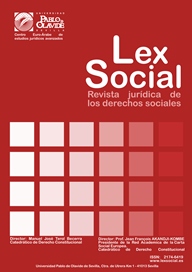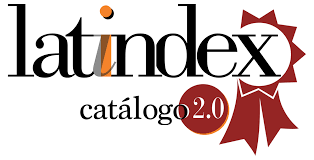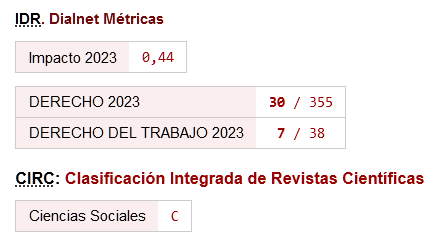The intervention of digital technology in the management of the safety and health of working people
DOI:
https://doi.org/10.46661/lexsocial.9647Keywords:
artificial intelligence, law, health and safety, regulation, working peopleAbstract
There are many articles, books, magazines and programs dedicated to digital technology and Artificial Intelligence (AI) and how it is going to modify our lives, -if it has not already done so- our consumption habits, relating to others and, of course, how it will affect the world of work and the labor market with predictions (almost catastrophic) that working people will be replaced by intelligent robots, machines or chatbots.
However, there is hardly any literature or studies that address the incursion of AI in the management of the safety and health of workers and even less how the proposal for the so-called Artificial Intelligence Law that is being processed in the European Commission addresses this. question.
In this study we try to present in a clear and simple way what an AI is, what health and safety management methods in which an AI intervenes currently exist, the risks that arise from them and how the standard deals with this challenge.
Downloads
References
ACKERMAN, M., Prevención de los riesgos del trabajo, obligación de seguridad del empleador y responsabilidad por daños a la salud del trabajador, en Tratado práctico a la legislación reguladora de los accidentes de trabajo y enfermedades profesionales, Granada, Comares, 2006.
AGUILAR DEL CASTILLO, M.C., El uso de la inteligencia artificial en la prevención de riesgos laborales, Revista Internacional y comparada de RELACIONES LABORALES Y DERECHO DEL EMPLEO, nº 1, 2020.
ALVAREZ CUESTA, H., La propuesta de reglamento sobre Inteligencia Artificial y su impacto en el ámbito laboral, en Algoritmos, Inteligencia Artificial y relación laboral, Cizur Menor (Navarra), Aranzadi, 2023.
CHU G., The experiments of wearable robot for carrying heavy-weight objects of shipbuilding Works, IEEE International Conference on Automation Science and Engineering (CASE), Singapore, 2014. https://doi.org/10.1109/CoASE.2014.6899445 DOI: https://doi.org/10.1109/CoASE.2014.6899445
DEL REY GUANTER, S., Inteligencia artificial y relaciones laborales: algunas implicaciones jurídicas, en Los desafíos del Derecho del Trabajo ante el cambio social y económico, Madrid, Iustel, 2021, p. 189.
FERNÁNDEZ GARCÍA, A., Los algoritmos y la inteligencia artificial en la Ley 12/2021, de 28 de septiembre, en Los nuevos escenarios laborales de la innovación tecnológica, Valencia, Tiran lo Blanch, 2023.
FERNÁNDEZ, T., Y TAMARO, E., Biografía de Alan Turing, En Biografías y Vidas. Barcelona, España, 2004.
GOÑI SEIN, J.L., El Reglamento UE de Inteligencia Artificial y su interrelación con la normativa de seguridad y salud en el trabajo, en Inteligencia Artificial y Prevención de Riesgos Laborales: obligaciones y responsabilidades, Tiran lo Blanch, Valencia, 2023.
GUILLÉN SUBIRÁN, C., Las posibilidades de Big Data en Seguridad y Salud en el Trabajo. 28 de abril, conmemorando el Día Mundial. Gestión práctica de riesgos laborales: Integración y desarrollo de la gestión de la prevención, nº, 147, 2017.
IGARTUA MIRÓ, M.T., La obligación de Seguridad 4.0, Temas Laborales, nº 151, 2020.
LAZCOZ MORATINOS, G., Análisis de la propuesta de reglamento sobre los principios éticos para el desarrollo, el despliegue y el uso de la inteligencia artificial, la robótica y las tecnologías conexas, Ius Et Scientia, vol. 6, nº 2, 2020.https://doi.org/10.12795/IETSCIENTIA.2020.i02.03 DOI: https://doi.org/10.12795/IETSCIENTIA.2020.i02.03
LLORENS ESPADA, J., Límites al uso de la Inteligencia Artificial en el ámbito de la Salud Laboral, Madrid, La Ley, 2023.
LÓPEZ DE MANTARÁS, R., El futuro de la IA: hacia inteligencias artificiales realmente inteligentes, ¿Hacia una nueva Ilustración? Una década trascendente. Madrid, BBVA, 2018.
MACÍAS GARCÍA, M.C., La inteligencia artificial para el entorno laboral. Un enfoque en la predicción de accidentes. e-Revista Internacional de la Protección Social, vol. nº 7, 2022.https://doi.org/10.12795/e-RIPS.2022.i01.05 DOI: https://doi.org/10.12795/e-RIPS.2022.i01.05
MACÍAS GARCÍA, M.C., La inteligencia artificial. Custodia de la seguridad y salud de las personas trabajadoras, e-Revista Internacional de la Protección Social, nº1 (extra), 2023. https://doi.org/10.12795/e-RIPS.2023.mon.13 DOI: https://doi.org/10.46661/lexsocial.9647
MARTÍNEZ GUZMÁN, M. D., Los recursos educativos abiertos para la formación en el trabajo, Etic@net: Revista científica electrónica de Educación y Comunicación en la Sociedad del Conocimiento, vol. 13, n.º 2, 2013. https://doi.org/10.30827/eticanet.v13i2.11994 DOI: https://doi.org/10.30827/eticanet.v13i2.11994
MERCADER UGUINA, J., Algoritmos e inteligencia artificial en el derecho digital del trabajo, Valencia, Tirant lo Blanch, 2022.
MINTZ Y, BRODIE R., Introduction to artificial intelligence in medicine, Minim Invasive Ther Allied Technol, nº 2, 2019.https://doi.org/10.1080/13645706.2019.1575882 DOI: https://doi.org/10.1080/13645706.2019.1575882
MOLINA NAVARRETE, C., El ciberacoso en el trabajo. Cómo identificarlo, prevenirlo y erradicarlo de las empresas, Madrid, Wolkers Kluwer, 2019.
MONEREO PÉREZ, J. L., Comentario a la Ley de Prevención de Riesgos Laborales y sus desarrollos reglamentarios, Granada, Comares, 2004.
MONEREO PÉREZ, J.L., Tratado práctico a la legislación reguladora de los accidentes de trabajo y enfermedades profesionales, Granada, Comares, 2006.
MUÑOZ RUIZ, A.B., Biometría y sistemas automatizados de reconocimiento de emociones: implicaciones jurídico-laborales, Valencia, Tirant lo Blanch, 2023.
PINTO FONTANILLO, J.A., El derecho ante los retos de la Inteligencia Artificial, Madrid, Edisofer, 2020.
RIVAS VALLEJO, P., La aplicación de la Inteligencia Artificial al trabajo y su impacto discriminatorio, Cizur Menor (Navarra), Aranzadi, 2020.
RODRÍGUEZ RODRÍGUEZ, P., Inteligencia artificial. Cómo cambiará el mundo (y tu vida), Barcelona, Deusto, 2018.
RODRÍGUEZ SANZ DE GALDEANO, B., Los sistemas de inteligencia artificial en el ámbito laboral y en el marco regulador europeo de seguridad del producto, en Inteligencia artificial y prevención de riesgos laborales: obligaciones y responsabilidades, Valencia, Tirant lo Blanch, 2023.
SEMPERE NAVARRO, A., Derecho de la Seguridad y la Salud en el Trabajo, Madrid, Civitas, 1996.
SPENCER F., La confianza es la piedra angular de la Ley de Inteligencia Artificial de la UE - De esto se trata. https://es.weforum.org/agenda/2023/04/esto-es-lo-que-dice-la-nueva-ley-de-inteligencia-artificial-de-la-union-europea/
TODOLÍ SIGNES, A., En cumplimiento de la primera Ley de la robótica: Análisis de los riesgos laborales asociados a un algoritmo/inteligencia artificial dirigiendo el trabajo, Labour & Law Issues, vol. 5, nº 2, 2019.
TODOLÍ SIGNES, A., Riesgos Laborales específicos del Trabajo en Plataformas Digitales, Barakaldo, OSALAN-Instituto Vasco de Seguridad y Salud Laborales, 2020.
TURING, A.M., ¿Puede pensar una máquina? Oviedo, KRK, Cuadernos de Pensamiento, 1950.
WILLIAN JIMÉNEZ, I., El contexto cambiante de los riesgos psicosociales. Riesgos emergentes y el impacto de la tecnología, en Los nuevos retos del trabajo decente: la salud mental y los riesgos psicosociales, Madrid, Universidad Carlos III de Madrid, 2020.
YANG, Q. & SHEN, Z., Active aging in the workplace and the role of intelligent technologies, IEEE International Conference on Automation Science and Engineering (CASE), Singapore, 2015. https://doi.org/10.1109/WI-IAT.2015.33 DOI: https://doi.org/10.1109/WI-IAT.2015.33
Downloads
Published
How to Cite
Issue
Section
License
Copyright (c) 2023 María del Carmen Macías García

This work is licensed under a Creative Commons Attribution-NonCommercial-ShareAlike 4.0 International License.
-
Atribución — Usted debe dar crédito de manera adecuada, brindar un enlace a la licencia, e indicar si se han realizado cambios. Puede hacerlo en cualquier forma razonable, pero no de forma tal que sugiera que usted o su uso tienen el apoyo de la licenciante.
-
NoComercial — Usted no puede hacer uso del material con propósitos comerciales.
-
CompartirIgual — Si remezcla, transforma o crea a partir del material, deberá difundir sus contribuciones bajo la misma licencia que el original.



 @Lex Social
@Lex Social Linkedin
Linkedin @lexrevista.bsky.social
@lexrevista.bsky.social


